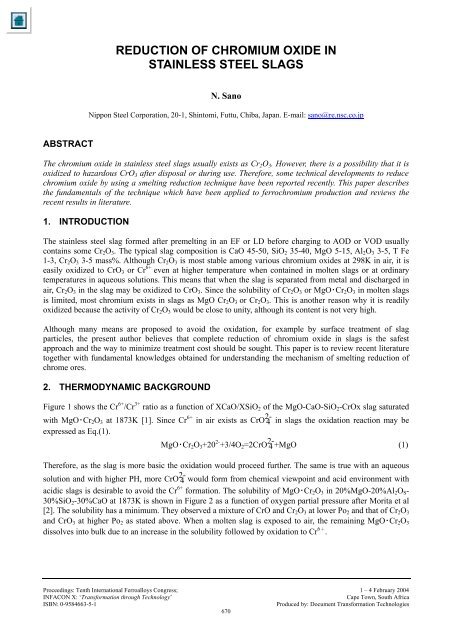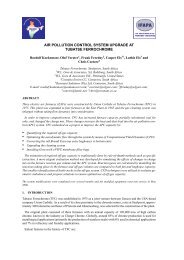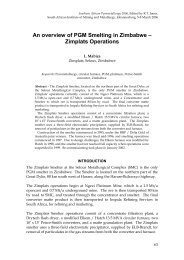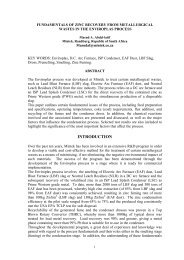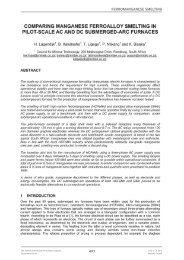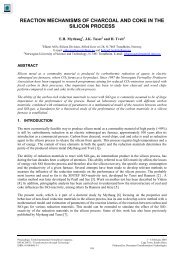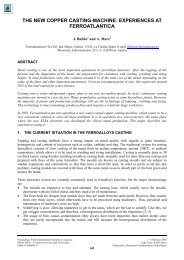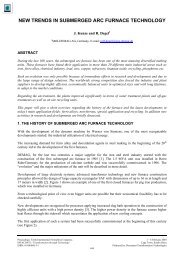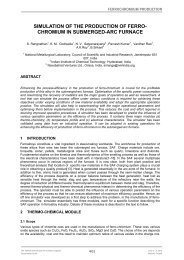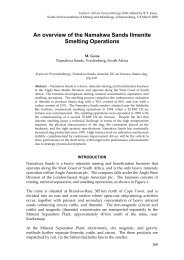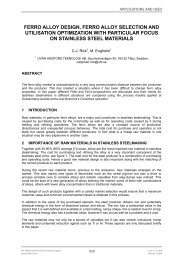Reduction of Chromium Oxide in Stainless Steel Slags - Pyro.co.za
Reduction of Chromium Oxide in Stainless Steel Slags - Pyro.co.za
Reduction of Chromium Oxide in Stainless Steel Slags - Pyro.co.za
- No tags were found...
You also want an ePaper? Increase the reach of your titles
YUMPU automatically turns print PDFs into web optimized ePapers that Google loves.
REDUCTION OF CHROMIUM OXIDE INSTAINLESS STEEL SLAGSN. SanoNippon <strong>Steel</strong> Corporation, 20-1, Sh<strong>in</strong>tomi, Futtu, Chiba, Japan. E-mail: sano@re.nsc.<strong>co</strong>.jpABSTRACTThe chromium oxide <strong>in</strong> sta<strong>in</strong>less steel slags usually exists as Cr 2 O 3 . However, there is a possibility that it isoxidized to ha<strong>za</strong>rdous CrO 3 after disposal or dur<strong>in</strong>g use. Therefore, some technical developments to reducechromium oxide by us<strong>in</strong>g a smelt<strong>in</strong>g reduction technique have been reported recently. This paper describesthe fundamentals <strong>of</strong> the technique which have been applied to ferrochromium production and reviews therecent results <strong>in</strong> literature.1. INTRODUCTIONThe sta<strong>in</strong>less steel slag formed after premelt<strong>in</strong>g <strong>in</strong> an EF or LD before charg<strong>in</strong>g to AOD or VOD usually<strong>co</strong>nta<strong>in</strong>s some Cr 2 O 3 . The typical slag <strong>co</strong>mposition is CaO 45-50, SiO 2 35-40, MgO 5-15, Al 2 O 3 3-5, T Fe1-3, Cr 2 O 3 3-5 mass%. Although Cr 2 O 3 is most stable among various chromium oxides at 298K <strong>in</strong> air, it iseasily oxidized to CrO 3 or Cr 6+ even at higher temperature when <strong>co</strong>nta<strong>in</strong>ed <strong>in</strong> molten slags or at ord<strong>in</strong>arytemperatures <strong>in</strong> aqueous solutions. This means that when the slag is separated from metal and discharged <strong>in</strong>air, Cr 2 O 3 <strong>in</strong> the slag may be oxidized to CrO 3 . S<strong>in</strong>ce the solubility <strong>of</strong> Cr 2 O 3 or MgO・Cr 2 O 3 <strong>in</strong> molten slagsis limited, most chromium exists <strong>in</strong> slags as MgO Cr 2 O 3 or Cr 2 O 3 . This is another reason why it is readilyoxidized because the activity <strong>of</strong> Cr 2 O 3 would be close to unity, although its <strong>co</strong>ntent is not very high.Although many means are proposed to avoid the oxidation, for example by surface treatment <strong>of</strong> slagparticles, the present author believes that <strong>co</strong>mplete reduction <strong>of</strong> chromium oxide <strong>in</strong> slags is the safestapproach and the way to m<strong>in</strong>imize treatment <strong>co</strong>st should be sought. This paper is to review recent literaturetogether with fundamental knowledges obta<strong>in</strong>ed for understand<strong>in</strong>g the mechanism <strong>of</strong> smelt<strong>in</strong>g reduction <strong>of</strong>chrome ores.2. THERMODYNAMIC BACKGROUNDFigure 1 shows the Cr 6+ /Cr 3+ ratio as a function <strong>of</strong> XCaO/XSiO 2 <strong>of</strong> the MgO-CaO-SiO 2 -CrOx slag saturatedwith MgO・Cr 2 O 3 at 1873K [1]. S<strong>in</strong>ce Cr 6+ <strong>in</strong> air exists as CrO 2- 4 <strong>in</strong> slags the oxidation reaction may beexpressed as Eq.(1).MgO・Cr 2 O 3 +20 2- +3/4O 2 =2CrO 2- 4 +MgO (1)Therefore, as the slag is more basic the oxidation would proceed further. The same is true with an aqueoussolution and with higher PH, more CrO 2- 4 would form from chemical viewpo<strong>in</strong>t and acid environment withacidic slags is desirable to avoid the Cr 6+ formation. The solubility <strong>of</strong> MgO・Cr 2 O 3 <strong>in</strong> 20%MgO-20%Al 2 O S -30%SiO 2 -30%CaO at 1873K is shown <strong>in</strong> Figure 2 as a function <strong>of</strong> oxygen partial pressure after Morita et al[2]. The solubility has a m<strong>in</strong>imum. They observed a mixture <strong>of</strong> CrO and Cr 2 O 3 at lower Po 2 and that <strong>of</strong> Cr 2 O 3and CrO 3 at higher Po 2 as stated above. When a molten slag is exposed to air, the rema<strong>in</strong><strong>in</strong>g MgO・Cr 2 O 3dissolves <strong>in</strong>to bulk due to an <strong>in</strong>crease <strong>in</strong> the solubility followed by oxidation to Cr 6+ .Proceed<strong>in</strong>gs: Tenth International Ferroalloys Congress; 1 – 4 February 2004INFACON X: ‘Transformation through Technology’Cape Town, South AfricaISBN: 0-9584663-5-1Produced by: Document Transformation Technologies
2.2 Sili<strong>co</strong>nSimilarly,CrO 1.5 +0.75Si=Cr+0.75SiO 2 (3)ΔG°= -6,440-29.3Τ J/mol [4]Suppose an iron melt <strong>co</strong>nta<strong>in</strong>s 1 mass% Si and 1 mass%Cr after reduction, %(Cr 3+ ) is 0.057 at 1773K. If 3%<strong>of</strong> carbon <strong>co</strong>exists <strong>in</strong> the metal, (%Cr 3+ ) is lowered to 0.023 because <strong>of</strong> a strong <strong>in</strong>teraction between carbonand sili<strong>co</strong>n with e C Si =0.18 [5].If ferrosili<strong>co</strong>n (70% Si), hav<strong>in</strong>g a Si =0.85, used as a reductant directly reacts with the slag, the rema<strong>in</strong><strong>in</strong>gchromium <strong>co</strong>ntent would be much less (0.83ppm).2.3 Alum<strong>in</strong>umCrO 1.5 +Al=Cr+AlO 1.5 (4)ΔG°= -20,600+20.8Τ J/mol [4]When slag is reduced by the metal <strong>co</strong>nta<strong>in</strong><strong>in</strong>g 1 mass% Al and 1 mass% Cr, the rema<strong>in</strong><strong>in</strong>g Cr 3+ <strong>co</strong>ntent iscalculated as 0.11ppm where aAlO 1.5 = 0.1 [6].The above calculations demonstrate that alum<strong>in</strong>um is the best reductant. If carbon is chosen due to its lower<strong>co</strong>st, carbon saturation is preferable. Sili<strong>co</strong>n is another choice and is widely used for reduction <strong>of</strong> a large<strong>co</strong>ntent <strong>of</strong> chromium oxide such as 25~30 mass% <strong>in</strong> the slag for premelt<strong>in</strong>g sta<strong>in</strong>less crude metal beforecharg<strong>in</strong>g to AOD, for example. Through those calculations the activity <strong>co</strong>efficient <strong>of</strong> CrO 1.5 was assumed tobe 7 ac<strong>co</strong>rd<strong>in</strong>g to Morita. et al [3] who showed that this value <strong>in</strong>creases with <strong>in</strong>creas<strong>in</strong>g basicity or CaO/SiO 2ratio for the CaO-SiO 2 -CrOx system (Figure 4). This suggests that chromium oxide <strong>in</strong> basic slags is easilyreduced. However, this is a mixed bless<strong>in</strong>g <strong>in</strong> that the rema<strong>in</strong><strong>in</strong>g Cr 2 O 3 is more easily oxidized to Cr 6+ after<strong>co</strong>ol<strong>in</strong>g as shown by Eq.(1). When MgO <strong>co</strong>exists as an actual case, the reducibility <strong>of</strong> CrOx would bedecreased, because the activity <strong>co</strong>efficient <strong>of</strong> CrOx slightly decreases with an addition <strong>of</strong> MgO [7].Figure 4. Effect <strong>of</strong> XCaO/XSiO 2 on the activityCoefficient <strong>of</strong> CrO 1.5 for the CaO-SiO 2 -CrOx systemat 1873K with Po 2 = 7・10 - 6 Pa [3].Figure 5. Influence <strong>of</strong> SiO 2 <strong>co</strong>ntent on the reduction<strong>of</strong> Cr 2 O 3 <strong>in</strong> high carbon ferrochromium slags bycarbon saturated iron [8].3. LABORATORY TESTS OF CHROMIUM OXIDE REDUCTIONThe author tested the reduction <strong>of</strong> chromium oxide <strong>in</strong> high carbon ferrochromium slags us<strong>in</strong>g a graphitel<strong>in</strong>ed rock<strong>in</strong>g furnace with 4kg <strong>of</strong> carbon saturated iron and 1kg <strong>of</strong> slag (CaO 7.2, MgO 25.4, Al 2 O 3 21.3,SiO 2 29.6, Cr 8.8 mass%) at 1873K The <strong>in</strong>terfacial area between metal and slag was 240cm 2 . The 3 mass%addition <strong>of</strong> SiO 2 to the orig<strong>in</strong>al 30% SiO 2 drastically enhanced the reduction rate [8] (Figure 5). UndissolvedMgO・Cr 2 O 3 was not observed micros<strong>co</strong>pically <strong>in</strong> the slag with SiO 2 addition. This addition lowered themelt<strong>in</strong>g po<strong>in</strong>t <strong>of</strong> the slag by 100K, lead<strong>in</strong>g to an <strong>in</strong>crease <strong>in</strong> its fluidity and mass transfer rate, s<strong>in</strong>ce the
dissolution <strong>of</strong> MgO・Cr 2 Os <strong>in</strong>to bulk slag is one <strong>of</strong> rate determ<strong>in</strong><strong>in</strong>g steps, where the solidity <strong>of</strong> MgO・Cr 2 O 3at 1873K is approximately 1 to 2 as mass%(Cr) (Figure 2).Fujita et al [9] <strong>in</strong>vestigated the smelt<strong>in</strong>g reduction behavior <strong>of</strong> prereduced chrome ore pellet us<strong>in</strong>g a 70kgcarbon saturated Fe-40%Cr with the slag (CaO/SiO 2 =1, Al 2 O 3 17%, MgO 17 mass%) together with <strong>co</strong>ke <strong>of</strong>5-10 mm size.Argon was blown through a porous plug at the furnace bottom. They found that at the first stage mass%(Cr)was reduced from 12 to 2 with a <strong>co</strong>nstant reduction rate, demonstrat<strong>in</strong>g that dissolution <strong>of</strong> MgO・Cr 2 O 3 <strong>in</strong>tobulk slag is a rate determ<strong>in</strong><strong>in</strong>g step. After % (Cr) was lowered below 2, the first order reaction was observed,suggest<strong>in</strong>g mass transfer <strong>co</strong>ntrol <strong>of</strong> (Cr) <strong>in</strong> slag (Figure 6). The rate <strong>co</strong>nstant was found to be <strong>co</strong>nstant up tomass% (MgO+Al 2 O 3 )>45 and as this parameter exceeds 45%, it significantly dropped (Figure 7). The Cr<strong>co</strong>ntent <strong>of</strong> the last slag was 0.3 mass%.Figure 6. Change <strong>in</strong> chromium <strong>co</strong>ntent <strong>of</strong> slag dur<strong>in</strong>gsmelt<strong>in</strong>g reduction <strong>of</strong> chromite ore with time [9].Figure 7. Effect <strong>of</strong> (MgO)+(Al 2 O 3 ) <strong>co</strong>ntent on thefirst order rate <strong>co</strong>nstant <strong>of</strong> reduction <strong>of</strong> Cr 2 O 3 [9].Miyamoto et al [10] recently <strong>in</strong>vestigated the smelt<strong>in</strong>g reduction behavior <strong>of</strong> Cr 2 O 3 <strong>in</strong> the slag to simulatechromium re<strong>co</strong>very from the slag to produce sta<strong>in</strong>less crude metal before decarburi<strong>za</strong>tion. They melted 70kg<strong>of</strong> Fe-C(-Cr) together with 3kg <strong>of</strong> the CaO-SiO 2 -Cr 2 O 3 -FeO-MgO-Al 2 O 3 slag with CaO/SiO 2 =2.5 at 1873Kand measured the reduction rate <strong>of</strong> Cr 2 O 3 as functions <strong>of</strong> <strong>in</strong>itial (Cr 2 O 3 ), (Al 2 O 3 ), C and Cr <strong>co</strong>ntents. All slags<strong>co</strong>nta<strong>in</strong>ed some solid oxide phases such as MgO・Cr 2 O 3 , FeO・Cr 2 O 3 , 2CaO・SiO 2 etc. depend<strong>in</strong>g on slag<strong>co</strong>mposition. Their typical <strong>in</strong>itial slag <strong>co</strong>mposition was CaO 39.3, SiO 2 15.7, Cr 2 O 3 35, FeO 5.0, MgO 5.0mass %.Their f<strong>in</strong>d<strong>in</strong>gs are summarized as follows:The additions <strong>of</strong> Al 2 O 3 and CaF 2 and lower CaO/SiO 2 ratio enhance the reduction <strong>of</strong> Cr 2 O 3 due to <strong>in</strong>creasedmass transfer rate <strong>of</strong> chromium <strong>in</strong> slag through <strong>in</strong>creased proportions <strong>of</strong> molten phase or less solid phase. Asthe reduction progressed, the proportion <strong>of</strong> solid phase decreased as shown <strong>in</strong> Figure 8. However, thoseprocedures lead to excessive erosion <strong>of</strong> MgO refractory so that they claim that the optimum slag <strong>co</strong>mpositionis CaO/SiO2=2.5 and mass%Al 2 O 3 ≒15 without CaF 2 . They also found the carbon <strong>co</strong>ntent up to 1 mass%<strong>in</strong>creases the reduction rate but beyond this <strong>co</strong>ntent the rate leveled <strong>of</strong>f. Increase <strong>in</strong> <strong>in</strong>itial chromium <strong>of</strong><strong>co</strong>ntent <strong>of</strong> the metal decreased the reduction rate and that <strong>of</strong> the slag <strong>in</strong>creased the rate. They <strong>co</strong>ncluded thereduction is mix-<strong>co</strong>ntrolled by the rate <strong>of</strong> dissolution <strong>of</strong> solid oxide (MgO・Cr 2 O 3 etc.) and that <strong>of</strong> masstransfer <strong>of</strong> chromium <strong>in</strong> metal.
Figure 8. Change <strong>in</strong> calculated proportions <strong>of</strong> phases <strong>in</strong> weight dur<strong>in</strong>g reduction [10].Shibata et al [11] reduced the CaO-SiO 2 -FeO-Al 2 O 3 slag <strong>co</strong>nta<strong>in</strong><strong>in</strong>g 0.4%Cr by alum<strong>in</strong>um, ferrosili<strong>co</strong>n andgraphite. The 0.2g <strong>of</strong> Al or Fe-Si was added every 60 se<strong>co</strong>nd with a total addition <strong>of</strong> 1.0g to 20g <strong>of</strong> the slagmelted <strong>in</strong> an alum<strong>in</strong>a crucible at 1823K. Simultaneously they oveserved the reduction by X ray fluoros<strong>co</strong>py.In the <strong>co</strong>urse <strong>of</strong> alum<strong>in</strong>um reduction the formed Al 2 O 3 disturbed further reduction and an <strong>in</strong>tense stirr<strong>in</strong>g wasneeded.The lowest Cr <strong>co</strong>ntent <strong>of</strong> 0.01 mass% was atta<strong>in</strong>ed. However, this is still one order <strong>of</strong> magnitude higher thanthermodynamic estimation. Higher temperatures and CaO/SiO 2 ratios enhanced reduction because <strong>of</strong><strong>in</strong>crease <strong>in</strong> fluidity <strong>of</strong> the slags. Metal droplets <strong>co</strong>nta<strong>in</strong><strong>in</strong>g Fe and Cr as reduction product were observed atthe bottom <strong>of</strong> the crucible (Figure 9). When Fe-Si was used, unreacted Fe-Si metal rema<strong>in</strong>ed at the upper part<strong>of</strong> the slag.Figure 9. Formation behavior <strong>of</strong> metal drop dur<strong>in</strong>g reduction by alum<strong>in</strong>um [11].
4. PILOT AND COMMERCIAL SCALE TESTSKawasaki <strong>Steel</strong> [12] developed a dust treat<strong>in</strong>g process (STAR process), utiliz<strong>in</strong>g the <strong>co</strong>ke packed bed typesmelt<strong>in</strong>g reduction. In this process tuyeres are provided at two stages. The powdery sta<strong>in</strong>less steel sludge(daily <strong>co</strong>nsumption is 140t) and dust is <strong>in</strong>jected through the upper tuyere and heated by the fuel suppliedfrom the lower tuyere (Figure 10).Figure 10. Pr<strong>in</strong>ciple <strong>of</strong> STAR Process [12].They are re<strong>co</strong>ver<strong>in</strong>g iron <strong>co</strong>nta<strong>in</strong><strong>in</strong>g C 3.9-4.2, Cr 7.7-8.5, Al 1.4-1.8 mass% and slag <strong>co</strong>mposition is T. Fe0.18-0.27, Cr 0.12-0.18, CaO 37-38, SiO 2 36-37, Al 2 O 3 14 mass% with chromium yield <strong>of</strong> 98%. This is<strong>co</strong>mmercial equipment which greatly <strong>co</strong>ntributes to establish their environment <strong>co</strong>nscious production <strong>of</strong>sta<strong>in</strong>less steel.Tschud<strong>in</strong> and Brotzmann [13] developed the HSR (Holsim Smelt<strong>in</strong>g Radix) process, which essentiallyreduces chromium oxide <strong>in</strong> sta<strong>in</strong>less steel slags <strong>in</strong> a BOF type furnace with blow<strong>in</strong>g oxygen and powdery<strong>co</strong>al through bottom and top blow<strong>in</strong>g <strong>of</strong> air (Figure 11). Typically, 3t <strong>of</strong> premelted slag was charged onto 10t<strong>of</strong> Fe-Cr-Cr metal from the previous heat. The chromium <strong>co</strong>ntent <strong>of</strong> the slag was lowered from 4.7 to 0.2mass% with 96.5% yield. If needed, further reduction by Fe-Si (0.4kg Si per kg Cr <strong>in</strong> slag ) lowered thechromium <strong>co</strong>ntent down to 0.02 mass%. This 0.4kg <strong>of</strong> Si is <strong>in</strong> ac<strong>co</strong>rd with stoichiometic calculationexclud<strong>in</strong>g the one needed to keep the sili<strong>co</strong>n <strong>co</strong>ntent at 2 mass% which is the calculated sili<strong>co</strong>n <strong>co</strong>ntent toatta<strong>in</strong> 0.02 (% Cr) by slag-metal equilibration under their <strong>co</strong>nditions. This aga<strong>in</strong> suggests that ferrosili<strong>co</strong>nreacts directly with chromium oxide <strong>in</strong> slag before dissolv<strong>in</strong>g <strong>in</strong>to a metal bulk. They <strong>co</strong>uld adjust the slag<strong>co</strong>mposition with CaO/SiO 2 =1.2~1.3 and mass%Al 2 O 3 =13 for use as a cement material. Leachability <strong>of</strong>Cr 6+ from a cement <strong>co</strong>nta<strong>in</strong><strong>in</strong>g 50% <strong>of</strong> this type slag was tested and they found that its leachability was 50%less than for ord<strong>in</strong>ary portland cement. The existence <strong>of</strong> (Cr 3+ )after reduction under strongly reduc<strong>in</strong>g<strong>co</strong>nditions is the reason for this f<strong>in</strong>d<strong>in</strong>g <strong>in</strong> ac<strong>co</strong>rdance <strong>of</strong> blast furnace slags.Figure 11. Consumption figures for treatment <strong>of</strong> 1t liquid <strong>in</strong>put <strong>of</strong> sta<strong>in</strong>less steel slags (HSR process) [13].
Burstron and Ye [13] tested the reduction for <strong>of</strong> chromium oxide <strong>in</strong> a 5t DC furnace at MEFOS (The IPBMprocess).Their typical slag <strong>co</strong>mposition is as follows. Fe 0.35, CaO 56.6, SiO 2 19.6, MnO 1.18, P 2 O 5 0.2, Al 2 O 3 21.9,MgO 2.85, Cr 2 O 3 0.03 mass% and slag temperature was 1953K.5. DISCUSSIONSAs reviewed above, carbon is the most realistic choice as a reductant <strong>of</strong> chromium oxide when iron is used asan absorber <strong>of</strong> reduced chromium. Thermodynamically as carbon <strong>co</strong>ntent decreases, its reduct<strong>in</strong>g powersignificantly drops. The metal after reduction may be recycled as long as the reduction furnace is locatednear a sta<strong>in</strong>less steel mak<strong>in</strong>g furnace. S<strong>in</strong>ce heat resource is the most important factor for treat<strong>in</strong>g slags, thisis an <strong>in</strong>dispensable <strong>co</strong>ndition.When sili<strong>co</strong>n is used as a reductant, two different mechanisms are possible, whether (1) ferrosili<strong>co</strong>n directlyreacts with slag or (2) it dissolves <strong>in</strong>to the metal and then sili<strong>co</strong>n <strong>in</strong> metal reacts with slag or a mixture <strong>of</strong> (1)and (2).Thermodynamically, the former case has a much higher sili<strong>co</strong>n activity than the latter. In the former case,formation <strong>of</strong> silica film on ferrosili<strong>co</strong>n particle dur<strong>in</strong>g reduction would leave it undissolved, result<strong>in</strong>g <strong>in</strong> loss<strong>of</strong> efficiency . In both cases, the necessary amount <strong>of</strong> ferrosili<strong>co</strong>n is the sum <strong>of</strong> (a) that used for reduction and(b) that to keep the sili<strong>co</strong>n <strong>co</strong>ntent high enough to keep the oxygen potential low. For example, slag<strong>co</strong>nta<strong>in</strong><strong>in</strong>g 25 mass% Cr 2 O 3 is reduced to 3% at 1923K, (a)12.2 and (b) 0.5kg/t <strong>of</strong> sili<strong>co</strong>n (total 12.7kg/t) arerequired, respectively, where the <strong>co</strong>exist<strong>in</strong>g metal <strong>co</strong>nta<strong>in</strong>s C 0.7%, Cr 16%, and Si 0.05 mass%. Actually12~13kg <strong>of</strong> sili<strong>co</strong>n as ferrosili<strong>co</strong>n(70~75%Si) is fed onto the slag [14]. Thermodynamically theequilibrium Cr 2 O 3 <strong>co</strong>ntent is calculated as 14 mass%, which is far higher than the obta<strong>in</strong>ed <strong>co</strong>ntent <strong>of</strong> 3mass%. In this case sufficient mix<strong>in</strong>g is desirable for effective reduction between Fe-Si and slag. When 1t <strong>of</strong>the slag <strong>co</strong>nta<strong>in</strong><strong>in</strong>g 3% Cr 2 O 3 is <strong>co</strong>mpletely reduced to harmless level <strong>of</strong> 0.05 as % (Cr) with 1 %Si <strong>in</strong> themetal, 44kg <strong>of</strong> sili<strong>co</strong>n is needed, if the weight ratio <strong>of</strong> slag to metal is 0.3. If the ratio can be <strong>in</strong>creased to 1,the needed sili<strong>co</strong>n amount would decrease to 20kg. Therefore the treatment should be done with a smallamount <strong>of</strong> metal.As a result, the best process would be reduction by carbon saturated iron with a small addition <strong>of</strong> sili<strong>co</strong>n atthe end. In this case the slag is treated after separation from sta<strong>in</strong>less crude metal where the method <strong>of</strong> heatsupply is most important. Therefore reduction should be carried out near a sta<strong>in</strong>less steel mak<strong>in</strong>g furnacebefore the slag solidifies. As <strong>in</strong> the HSR process, oxygen on air blow<strong>in</strong>g with some carbonaceous fuel wouldbe a solution.Thermodynamically alum<strong>in</strong>um is the best reductant except for <strong>co</strong>st. Industrial waste such as alum<strong>in</strong>um drossmay be used if it is available near location <strong>of</strong> a sta<strong>in</strong>less steel plant.6. CONCLUSIONSIn this paper the reduction <strong>of</strong> chromium oxide sta<strong>in</strong>less steel slags was shown to be technically feasible byreview<strong>in</strong>g fundamental knowledges for smelt<strong>in</strong>g reduction <strong>of</strong> chrome ore <strong>in</strong> the past and the results <strong>of</strong> recentpilot plant tests.The only problem to be solved is how to supply heat for treatment after separation <strong>of</strong> the bulk metal. S<strong>in</strong>cethe price <strong>of</strong> treated slag is not expected to be high, a large <strong>in</strong>vestment may not be possible. However, theauthor believes that <strong>in</strong> order to <strong>co</strong>nt<strong>in</strong>ue to produce sta<strong>in</strong>less steel without much <strong>co</strong>ncern <strong>in</strong> future an<strong>in</strong>troduction <strong>of</strong> the slag treatment process is <strong>co</strong>mpulsory and some <strong>in</strong>vestment may be worthy to establish anenvironment <strong>co</strong>nscious process.
7. REFERENCES[1] K. Morita, T. Shibuya and N. Sano : Testu to Hagane, 74, 1988, pp. 632-639.[2] K. Morita, A Inoue, N. Takayama and N. Sano, ibid, pp. 999-1005.[3] K. Morita, M. Mori, M. Guo and N. Sano : <strong>Steel</strong> Res., 70, 1999, pp. 319-324.[4] E. T. Turkdogan : Physical Chemistry <strong>of</strong> High Temperature Technology, Academic Press, New York,1980.[5] The Japan Society <strong>of</strong> the Promotion <strong>of</strong> Science, The 19th Committee on <strong>Steel</strong>mak<strong>in</strong>g, <strong>Steel</strong>mak<strong>in</strong>g DataSourcebook, Gorden and Breach Science Publishers, New York, 1988, pp.291.[6] Slag Atlas, edited by VDEh, Verlag Stahleisen, Dusseldorf, 1995, pp237.[7] Y. Xiao and L. Holappa : ISIJ. Int. 33, 1993, pp. 66-74.[8] M. Maeda, N. Sano and Y. Matsushita : Conservation and Recycl<strong>in</strong>g, 4, 1981, pp. 2131-2137.[9] M Fujita, H. Katayama, M. Kuwabara, C. Saitou, H. Ishikawa and H. Kajioka : Tetsu to Hagane, 74,1988, pp. 680-687.[10] K. Miyamoto, K. Kato and T. Yuki : Tstsu to Hagane, 88, 2002, pp. 838-844.[11] E. Shibata, S. Egawa and T. Nakamura : ISIJ Int., 42, 2002, pp. 609-613.[12] H. Itaya, Y. Hara, S. Taguchi, S. Hasegawa, M. Nomura and Y. Matsumoto, Rev. Metall., 94, 1997, pp.64-70.[13] M. Tschud<strong>in</strong> and K. Brotzmann : Proceed<strong>in</strong>gs <strong>of</strong> Recycl<strong>in</strong>g and Waste Treatment <strong>in</strong> M<strong>in</strong>eral and MetalProcess<strong>in</strong>g, vol. 2, TMS, Lulea, Sweden, 2002.[14] E. Burstrom and G. Ye : New Melt<strong>in</strong>g TechnologiesⅡ, ISS, Pittsburgh, 2002.[15] K. Miyamoto, Private Communication, Nippon <strong>Steel</strong>, Yawata Works.


